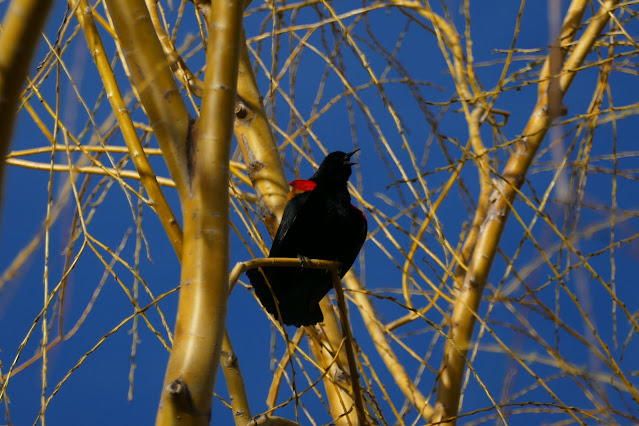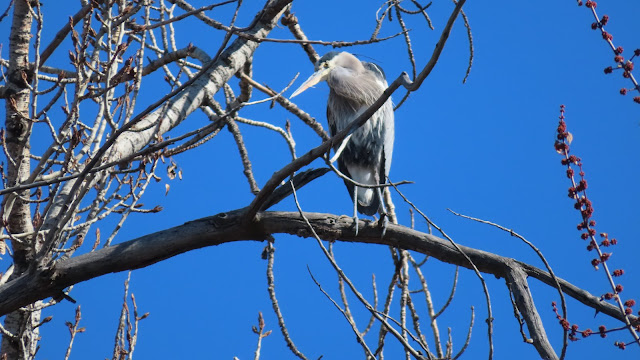 |
Entrance to Centennial Marsh with Camas flowers in the background.
|
A week ago we drove about 100 miles southeast of Boise for a day of birding and exploring around the Camas Prairie - Centennial Marsh Wildlife Management Area (WMA). This is a unique and valuable landscape, sitting at approximately 5000 feet. It is high prairie, seasonally flooded wetland which serves multiple ecological functions with the primary purpose to provide wetland and upland habitat for migratory and resident wildlife. It is managed by Idaho Fish and Game. We thought that we might have been too late to see the Camas lilies in bloom, but were pleased to see patches of them still blooming in the fields around the marsh.
 |
Old school house and cliff swallows
|
.JPG)
We entered the area from Schoolhouse Road off Highway 20. A little ways down the road was an old schoolhouse. Upon closer inspection, we could see that it was occupied, not by students, but by hundreds of Cliff swallows. Standing outside, it was reminiscent of a scene from Alfred Hitchcock's movie The Birds. Although harmless, they did not seem to happy with our presence, so we decided to move along quickly and let them be.
I had heard about the Phalaropes that migrate to this area, so I was thrilled to see Wilson Phalaropes, swimming amongst the reeds, in a ditch just along the side of the road.
.JPG) |
Wilson's Phalarope
|
Atypical of most birds, the female Phalarope is more colorful than the male. She takes the lead in courtship and will often mate with more than one male in a season. It is the male who will incubate the eggs and raise the young. In late summer, Wilson's Phalaropes will migrate to South America, gathering in large flocks in salty lakes along the way.
We saw lots of Brewer's blackbirds, including several that were gathering nesting materials, as in the photo below.
.JPG) |
Brewer's blackbird
|
The male Brewer's blackbird is easy to recognize, with its shiny iridescent colors and bright yellow eyes. The female, on the other hand, is brown and does not have yellow eyes. The colors and yellow eyes are similar to the Common Grackle, which is a larger bird and has a stockier bill. Their ranges have begun to overlap in the last century as Brewer's have moved east into the Great Lakes Region and Grackles are now increasing in the west.
We saw many Horned Larks, a first for me. I did not know what they were at first, as I did not see any "horns," which are actually two tufts of hair that will stick up on the top of its head. It is certainly a unique looking bird, especially the male which has a black mask and yellow throat. We saw them on fence posts and on the ground, where they forage for food.
 |
Horned lark
|
Another common prairie-loving bird is the Meadowlark. They are prevalent in open grasslands, including agricultural areas. Oftentimes I will hear them close-by, but never see them. This day they sang out in the open. When in flight, they are easy to identify with their white outer tail feathers being quite visible. Although they are widespread and not uncommon, their population has shown declines in recent decades. This decline may continue as increasing development puts pressure on their habitats. They nest on the ground, and will abandon their eggs if they are disturbed by human interference such as mowing.
 |
Western Meadowlark
|
If you have never seen a Sandhill Crane, you will definitely be impressed by their size. They are about the size of a Great Blue Heron, around four feet tall, but seem larger as they walk upright with their necks erect. They are one of the historically oldest bird species. A fossil discovered in Florida was dated at around two and a half million years. Sandhill Cranes start breeding between the ages of two and seven years and will mate for life. They only lay one to three eggs a season and will rear their young for almost a year.
 |
Sandhill Cranes amongst Camas lilies
|
I am not very good at identifying sparrows, but Vesper sparrows have a couple unique characteristics which makes them easier to identify. In the photo below you can see a very visible white eye-ring and a small rust patch on its shoulder.
.JPG) |
Vesper sparrow
|
Yellow-headed blackbirds are a cool looking bird, if not a little creepy. They have a large yellow head and breast which makes their black eyes stand out. Their sound is a large honk which you can checkout here. They breed around marshes in similar habitat as red-winged blackbirds. When they are not nesting, they hang out with other blackbirds in open fields. We saw them in both the fields and the marshlands.
 |
Yellow-headed and Brewer's blackbirds
|
By entering the WMA from the west, we ended our visit at Centennial Marsh. Here, there are picnic tables and an outhouse. There are also paths that lead to the edge of the water. On the pond we saw Gadwalls, Cinnamon Teals, Rudy ducks, Canada geese, American Coots and Eared Grebes.
.JPG) |
Centennial Marsh
|
After stopping for a late lunch in Fairfield, we headed back west on highway 20 toward Mountain Home. But, instead of taking this road directly to I-84, we turned right at the Toll Gate historical marker, and took Immigrant Road which is part of the Oregon Trail Back Country Byway.
 |
Oregon Trail Byway
|
It was passable, but may prove difficult in early spring, or following a rain storm. Along the way, we saw more Horned Larks, Sandhill Cranes and a couple Long-billed Curlews. The later are an amazing bird to observe with its disproportionately long bill. It breeds in western grasslands and winters along the coast. In 2009, Boise State's Intermountain Bird Observatory (IBO) began a long-term study of Long-billed Curlew breeding populations to better understand the reasons for their decline. This led to the 2020 publication of an article https://www.researchgate.net/publication/344355529_Illegal_killing_of_nongame_wildlife_and_recreational_shooting_in_conservation_areas which documented the poorly studied problem of illegal killing of non-game wildlife in conservation areas of Idaho. Please visit the link above to learn more about this study and click here to follow the ongoing IBO research on Long-billed Curlews.
.JPG) |
Long-billed curlew
|
I hoped that this blog has piqued your interest to visit Camas Prairie Centennial Marsh, and if you do come, pack some snacks or a lunch and plan on spending several hours in order to fully appreciate both the grassland and wetland habitats.
.JPG)
.JPG)
.JPG)


.JPG)
.JPG)
.JPG)



.JPG)

.JPG)

.JPG)



.JPG)
.JPG)
.JPG)
.JPG)






.JPG)
.JPG)

.JPG)
.JPG)






